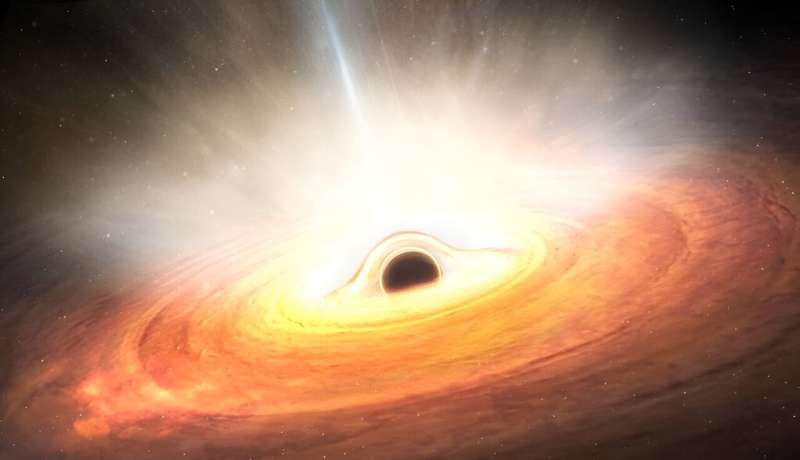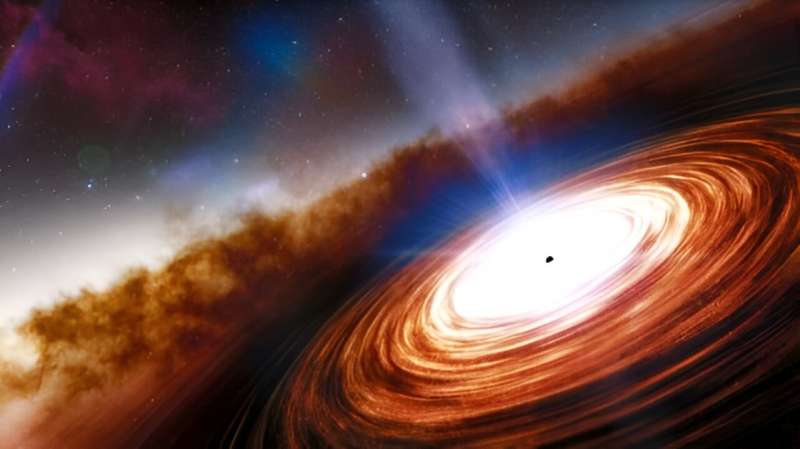This article has been reviewed according to Science X's editorial process and policies. Editors have highlighted the following attributes while ensuring the content's credibility:
fact-checked
peer-reviewed publication
trusted source
proofread
A black hole has cleared out its neighborhood

We can't see them directly, but we know they're there. Supermassive black holes (SMBHs) likely dwell at the center of every large galaxy. Their overwhelming gravity draws material toward them, where it collects in an accretion disk, waiting its turn to cross the event horizon into oblivion.
But in one galaxy, the SMBH has choked on its meal and spit it out, sending material away at high speeds and clearing out the entire neighborhood.
We've known there's something at the heart of large galaxies since the early 1960s when astronomers discovered an unexplained radio source at the center of a giant elliptical galaxy. Astronomers thought it was a star, but its spectrum didn't make sense. And since it was so far away, about 2.4 billion light-years distant, that meant it was emitting the energy of hundreds of galaxies. The rate of light emitted by the object varied, and the term quasar (quasi-stellar object) was created to describe it.
More quasars were discovered in the following years, and eventually, astronomers realized that gas falling into a massive compact object could create what they were seeing. More studies showed that the gas forms a rotating disk around the object, called an accretion disk. Astronomers also observed stars moving strangely near the center of galaxies, and only a massive object could explain their velocities and movement.
By the 1970s, astronomers thought that there was one of these massive objects at the Milky Way's center. In 1974, astronomers discovered it and named it Sagitarrius A-star. Eventually, more and more evidence showed that most, if not all, large galaxies have SMBHs at their center. Now we understand the link between the accretion disk, the black hole, and active galactic nuclei (AGN), which are black holes that are actively consuming material and emitting lots of radiation.
So, this is our current picture of SMBHs. They're massive compact objects that lurk at the centers of galaxies. They can have hundreds of millions, even billions, of solar masses. SMBHs draw material toward them, and the material collects in an accretion disk. The disk heats up and emits radiation, and tangled magnetic fields cause astrophysical jets to shoot out of the poles.

Not all of the material in the accretion disk makes it past the event horizon. SMBHs only consume a fraction of the disk material. Once they reach the Eddington Limit, the rest is sent tumbling out into space, dragging some of the gas in the galactic center with it.
Astronomers have spotted a distant SMBH in the galaxy Markarian 817 that has broken this picture. Beyond an SMBH's accretion disk, neutral gas and dust form a torus. In the same region, clouds of interstellar star-forming gas reside just beyond the SMBH's gravitational reach. The distant SMBH sent so much material from the disk out into space at high speed that it cleared out all of the gas in the region. That stifled star formation in the galactic center.
The discovery is presented in new research in The Astrophysical Journal Letters. It's titled "Fierce Feedback in an Obscured, Sub-Eddington State of the Seyfert 1.2 Markarian 817." The lead author is Miranda Zak, an undergraduate researcher at the University of Michigan.
Astronomers have found SMBHs that are driving material away from their galactic centers before. They call this "black hole wind," and they've detected it around extremely bright accretion disks that have reached the limit for how much material they can accumulate. The black hole wind throws the excess material out into space.
But in Markarian 817, the disk is not very bright. That means it shouldn't be at its Eddington Limit or mass accumulation limit. It's only "snacking" according to a press release announcing the discovery.
"You might expect very fast winds if a fan was turned on to its highest setting. In the galaxy we studied, called Markarian 817, the fan was turned on at a lower power setting, but there were still incredibly energetic winds being generated," said study co-author Miranda Zak.
In scientific terms, these winds are called ultra-fast outflows (UFOs.) UFOs have velocities of many millions of miles per hour, and astronomers have found them coming from accretion disks that have reached their Eddington Limits. But this is different.
"UFOs are often detected at or above the Eddington limit; this result signals that black hole accretion has the potential to shape host galaxies even at modest Eddington fractions," the authors write in their research.
Black hole accretion and the resulting UFOs can quench star formation near the galactic center by blowing all of the gas away. The powerful wind also carries away the SMBH's fuel, and without new gas to feed its accretion disk, it emits far less light.
"It is very uncommon to observe ultra-fast winds and even less common to detect winds that have enough energy to alter the character of their host galaxy. The fact that Markarian 817 produced these winds for around a year while not being in a particularly active state suggests that black holes may reshape their host galaxies much more than previously thought," added co-author Elias Kammoun, an astronomer at the Roma Tre University in Italy.
Multiple telescopes and observatories contributed to this discovery. When material in an accretion disk heats up, it emits X-rays. However, when researchers observed Markarian 817 with NASA's Swift observatory, the X-rays were nearly undetectable. "The X-ray signal was so faint that I was convinced I was doing something wrong!" exclaimed lead author Miranda Zak.
But Swift isn't our best X-ray observatory. So, the astronomers turned to the ESA's XMM-Newton X-ray observatory. Those observations showed that Markarian 817's UFO was blocking out X-rays from the SMBH's corona, the hole's immediate surroundings. Another X-ray observatory, NASA's NuSTAR telescope, confirmed those observations: the X-rays were there, just obscured.
Markarian 817's UFO only lasted about one year. But during that time, it reshaped the center of the galaxy. This study shows in clear detail how black holes and their host galaxies shape each other and have powerful effects on each other's evolution.
The study also sheds light on why some galactic centers, the Milky Way's included, don't exhibit much active star formation. The SMBHs at their centers have blown away the star-forming gas. But this can only happen if the UFO is both powerful enough and long-lasting enough.
SMBH accretion and feedback, and how it shapes the galaxy that hosts it, is something astrophysicists are eager to learn more about. In this instance, the ESA's XMM-Newton played a critical role in determining what was going on in Markarian 817.
Norbert Schartel is a project scientist for XMM-Newton. Though not a part of this research directly, Schartel spoke about how important XMM-Newton is to decipher what's going on near SMBHs.
"Many outstanding problems in the study of black holes are a matter of achieving detections through long observations that stretch over many hours to catch important events. This highlights the prime importance of the XMM-Newton mission for the future. No other mission can deliver the combination of its high sensitivity and its ability to make long, uninterrupted observations," said Schartel.
More information: Miranda K. Zak et al, Fierce Feedback in an Obscured, Sub-Eddington State of the Seyfert 1.2 Markarian 817, The Astrophysical Journal Letters (2024). DOI: 10.3847/2041-8213/ad1407
Journal information: Astrophysical Journal Letters
Provided by Universe Today




















